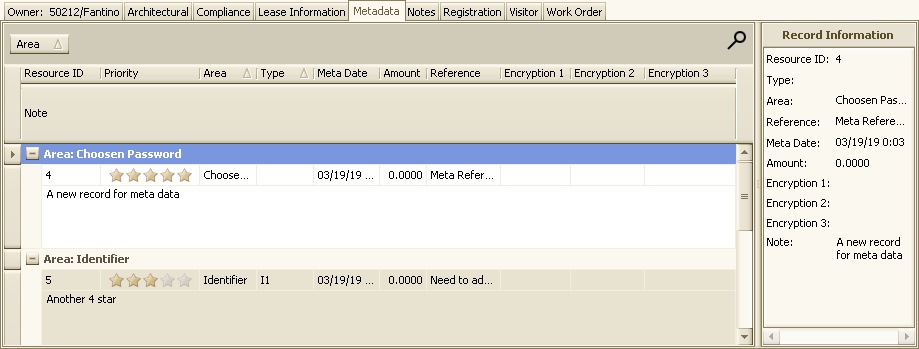As discussed earlier in CLASS TWO, Metadata is also available at the resident level. This feature is useful when there is a need to store random pieces of information for an account, but in a centrally located area in the system. This may be used to store information that is specific to the unit or the resident.
The Metadata tab is accessed through APPLICATIONS | Account Maintenance Group | Account | Metadata.

The fields are defined as follows:
Field |
Description |
|---|---|
Resource ID |
Automatically generated identification number. |
Priority |
Allows user to assign a priority level or level of importance. |
Area |
Allows user to assign the metadata record to a specific area that they have predefined in SETUP | Configuration Group | Program Defaults | Codes | Program Area: Account Meta Area. |
Type |
Corresponds directly to the Area selected. Predefined by user in SETUP | Configuration Group | Program Defaults | Codes | Program Area: Account Meta Area. |
Meta Date |
Defaults to current date but can be modified by the user. |
Amount |
Allows user to enter a dollar amount if needed. |
Reference |
Allows user to select a reference type that is predefined in SETUP | Configuration Group | Program Defaults | Codes | Program Area: Account Meta Reference. |
Encryption 1, 2, 3 |
Allows user to add private information to keep it secure. The information in these fields cannot be pulled into a report. |
Notes |
Allows user to add a detailed note for each record. This field can be moved in line with the other column headings by clicking and dragging and dropping the Notes column heading in with the others. |
Some examples of information that can be stored in Metadata records are: contracts, insurance policies, front gate access, etc.
One specific example is: If the association has a gate or door code assigned to each resident, that information can be stored in a Metadata record and pulled into a report.
Another specific example is: If a resident gives the manager a copy of their insurance policy, the manager can scan a copy of the insurance policy and save it in the Notes tab within the owner's account. Then the manager can enter the basic information about the policy in the Metadata record. They can then reference the Resource ID number from the Notes tab in the Note field in the Metadata record. This saves time with having to search through all the notes in the Notes tab for this particular item.